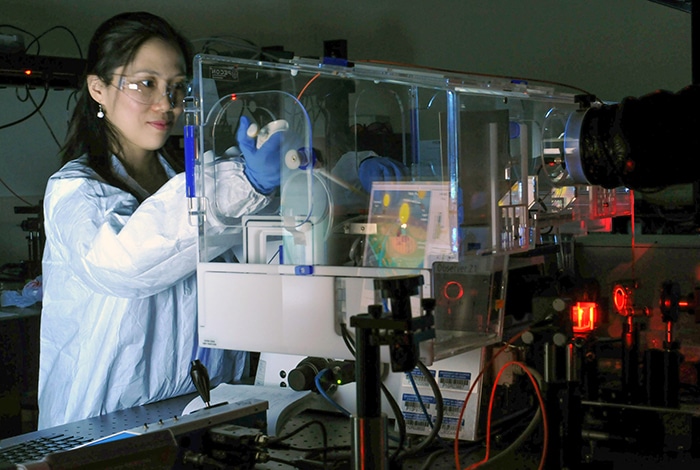Feb 1 2017
 University of Illinois post-doctoral researcher Yue Zhuo performs a technique for imaging live cells. Researchers developed the method, called photonic crystal-enhanced microscopy (PCEM), as an advantageous alternative to imaging with fluorescent dyes. (Credit: Photo by Grant Pluta.)
University of Illinois post-doctoral researcher Yue Zhuo performs a technique for imaging live cells. Researchers developed the method, called photonic crystal-enhanced microscopy (PCEM), as an advantageous alternative to imaging with fluorescent dyes. (Credit: Photo by Grant Pluta.)
Scientists funded by the National Institutes of Health have built a new tool to monitor the way cells attach to an adjoining substrate under a microscope.
Analyzing adhesion events can help researchers to understand the way diseases spread, tissues grow, and stem cells differentiate into many specific cell types. The technique provides high-resolution images that can monitor the interactions of cells across longer time periods than previously possible.
Researchers from the University of Illinois at Urbana-Champaign published details of their study in the November 2016 issue of the Progress in Quantum Electronics journal. The researchers demonstrated the method known as photonic crystal-enhanced microscopy (PCEM), on various types of cancer cells and stem cells, revealing that each cell type had its own exclusive adhesion properties.
Being able to track cells over days with such sensitivity will allow researchers to quantify exactly when these events happen and get a better understanding of the how and why.
Rosemarie Hunziker, Ph.D.
Hunziker is the director of the National Institute of Biomedical Imaging and Bioengineering (NIBIB) program in Tissue Engineering and Regenerative Medicine
Adhesion is an essential process throughout the lifespan of a cell, spanning from division and differentiation to migration and death. However tracking these events is tough - whether happening among cells in the body or when cells stick to the surface of a dish in the lab.
Most techniques rely on expressing fluorescent dyes in the cells, but the fluorescence can be difficult to calibrate and exposes cells to fluorescent light for lengthy time periods that can harm the cells.
To spot adhesion events, the team used a photonic crystal sensor, which comprises of a synthetic crystal with the ability to manipulate and distinguish specific wavelengths of light. The sensor was coated with extracellular matrix molecules - proteins that accumulate close to the surface of cells and help boost cell attachment.
When a cell adheres to these molecules, the wavelength of light usually refracted off the sensor is shifted, and the sensor captures the shift, identifying the interaction.
The system’s sensitivity enabled researchers to count and track adhesion events over a period of time. While fluorescent light hampers cell imaging to a few minutes at a time across a span of hours, this system uses a LED source, instead of fluorescence, so the cells can be imaged over a span of days to weeks without being harmed.
The new technique will make it simpler to test occurrences at the membrane reproducibly and more reliably, without having to label the cells.
We’re addressing this fundamental capability of single cells or multiple single cells within a culture and watching their behavior, their attachment and release behavior over time.
Brendan Harley, Sc.D., Professor of Chemical and Biomolecular Engineering, University of Illinois at Urbana-Champaign
Applying the crystal sensor in this new approach provides several research possibilities. “This is really an untapped imaging approach that hasn’t had a lot of use in looking at cell behavior,” says Harley. “We’re excited about how far can we push this tool to really watch differentiation of stem cells in real time over multiple day processes.”
“All these things that happen through the cell membrane,” says Richard Conroy, Ph.D., former director of the NIBIB program in Molecular Imaging. “The key part here is being able to put some numbers to all of what’s going on.”
Future studies can incorporate drugs and treatments to analyze their effects on cell binding, use varied extracellular matrix molecules to investigate the necessary interactions at the surface, or quantify the varied cellular receptors involved to better comprehend the way communication works at the cell membrane.
The research was funded by NIH grants EB018481 and DK099528.